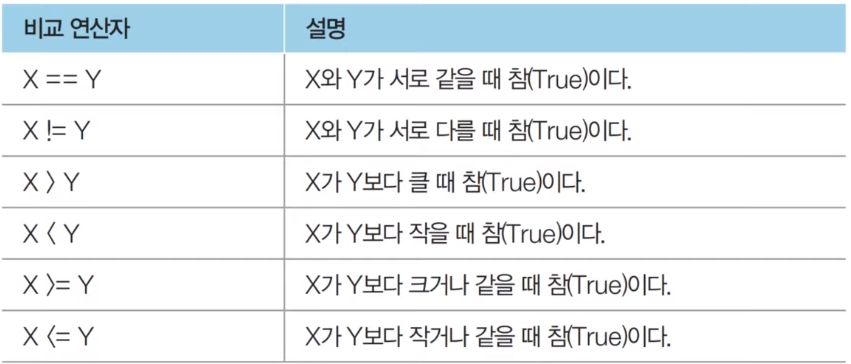목표
- 입출력, 조건문, 반복문, 함수에 대해서 알아보기
기본 입출력
input() 함수
- 한 줄의 문자열을 입력 받는 함수
map() 함수
- 리스트의 모든 원소에 각각 특정한 함수를 적용할 때 사용
예시) 공백을 기준으로 구분된 데이터를 입력 받을 때는 다음과 같이 사용
- list( map ( int, input().split() ) )
예시) 공백을 기준으로 구분된 데이터의 개수가 많지 않다면?
- a, b, c = map( int, input().split() )
< 예시 >
# 데이터의 개수 입력
n = int( input() )
# 각 데이터를 공백을 기준으로 구분하여 입력
data = list( map( int, input().split() ) )
data.sort( reverse = True )
# 각 데이터를 문자열로 출력
data2 = input().split()
# 세개의 변수를 입력받아 출력
a, b, c = map( int, input().split() )
print( n )
print( data )
print( data2 )
print( a, b, c )< 결과 값 >
입력 ==========
5
10 20 30 40 50
50 40 30 20 10
1 2 3
출력 ==========
5
[50, 40, 30, 20, 10]
['50', '40', '30', '20', '10']
1 2 3빠르게 입력받기
- 사용자로부터 입력을 최대한 빠르게 받아야 하는 경우
- 파이썬의 경우 sys 라이브러리에 정의되어 있는 sys.stdin.readline() 메서드 이용
- 단, 입력 후 엔터(Enter)가 줄 바꿈 기호로 입력되므로 rstrip() 메서드 함께 사용
< 예제 >
import sys
# 문자열 입력 받기
data = sys.stdin.readline().rstrip()
print(data)< 결과 값 >
입력 ==========
1 2 3 4 5
출력 ==========
1 2 3 4 5자주 사용되는 표준 출력 방법
- 파이썬에서 기본 출력은 print() 함수를 이용
- 각 변수를 콤마(,)를 이용하여 띄어쓰기로 구분하여 출력 가능
- print()는 기본적으로 출력 이후 줄 바꿈을 수행
- 줄 바꿈을 원치 않는 경우 'end' 속성을 이용
< 예제 >
# 출력할 변수들
a = 1
b = 2
print( a, b)
print( 7, end=" ")
print( 8, end=" ")
# 출력할 변수
answer = 7
print( "정답은 " + str(answer) + "이다." )< 결과 값 >
1 2
7 8 정답은 7이다.f-string
- 파이썬 3.6부터 사용 가능
- 문자열 앞에 접두사 'f'를 붙여 사용
- 중괄호 안에 변수명을 기입하여 간단히 문자열과 정수를 함께 넣음
< 예제 >
answer = 7
print( f"정답은 {answer}이다.")< 결과 값 >
정답은 7이다.조건문
- 프로그램의 흐름을 제어
- 프로그램 로직 설정
< 예제 >
x = 15
if x >= 10:
print("x >= 10 ")
if x >= 0:
print("x >= 0")
if x >= 30:
print("x >= 30")< 결과 값 >
x >= 10
x >= 0들여쓰기
- 파이썬에서는 코드의 블록(Block)을 들여쓰기(Indent)로 지정
- 파이썬 스타일 가이드라인에서는 4개의 공백 문자를 사용하는것을 표준으로 설정
< 예제 >
score = 85
if score >= 70 :
print( '성적이 70점 이상입니다. ')
if score >= 90 :
print('우수한 성적입니다.')
else :
print('성적이 70점 미만입니다.')
print('조금 더 분발하세요.')
print( '프로그램을 종료합니다.')< 결과 값 >
성적이 70점 이상입니다.
프로그램을 종료합니다.조건문의 기본 형태
- 기본형태는 if ~ elif ~ else 이다.
- 조건문을 사용할 때 elif 혹은 else 부분은 경우에 따라 사용하지 않아도 된다.
< 예제 >
a = -15
if a >= 0 :
print( "a >= 0")
elif a >= -10 :
print("0 > a >= -10")
else:
print("-10 > a")< 결과 값 >
-10 > a비교 연산자
- 특정한 두 값을 비교할 때 이용
- 대입 연산자(=) 같음 연산자(==)의 차이점에 유의

논리 연산자
- 논리 값( True/False ) 사이의 연산을 수행할 때 사용

< 예제 >
if True or False:
print("Yes")
a = 15
if a <= 20 and a >= 0 :
print( "Yes" )< 결과 값 >
Yes
Yes기타 연산자
- 다수의 데이터를 담는 자료형을 위해 in 연산자와 not in연산자 가 제공된다.
- 리스트 , 튜플 , 문자열, 딕셔너리 모두에서 사용이 가능

pass 키워드
- 아무것도 처리하고 싶지 않을 때 사용
- 예시 ) 디버깅 과정에서 일단 조건문의 형태만 만들어 놓고 조건문을 처리하는 부분은 비워놓고 싶은 경우
< 예제 >
score = 85
if score >= 80 :
pass # 나중에 작성할 소스코드
else :
print( '성적이 80점 미만입니다.' )
print( '프로그램을 종료합니다.' )< 결과 값 >
프로그램을 종료합니다.조건문의 간소화
- 조건문에서 실행될 소스코드가 한 줄인 경우, 굳이 줄 바꿈을 하지 않고도 간략하게 표현할 수 있다.
< 예제 >
score = 85
if score >= 80 : result = "Success"
else : result = "Fail"
print(result)< 결과 값 >
Success- 조건부 표현식 ( Conditional Expression )은 if ~ else문을 한 줄에 작성
< 예제 >
score = 85
result = "Success" if score >= 80 else "Fail"
print(result)< 결과 값 >
Success조건문 내에서의 부등식
- 다른 프로로그래밍과 다르게 파이썬은 조건문 안에서 수학의 부등식을 그대로 사용 가능
- 예시 ) 'x > 0 and x < 20' 과 '0 < x < 20' 은 같은 결과를 반환
< 코드 스타일 1 >
x = 15
if x > 0 and x < 20 :
print( "x는 0이상 20 미만의 수이다." )< 코드 스타일 2 >
x = 15
if 0 < x < 20:
print( "x는 0이상 20 미만의 수" )반복문
< 1부터 9까지 모든 정수의 합 구하기 예제 ( while문 ) >
i = 1
result = 0
# i가 9보다 작거나 같을 때 아래 코드를 반복적으로 실행
while i <= 9:
if i % 2 == 1:
result += i
i += 1
print( result )< 결과 값 >
25for문
- 특정 변수를 이용하여 'in' 뒤에 오는 데이터( 리스트, 튜플 등 )에 포함되어 있는 원소를 첫 번째 인덱스로부터 차례대로 하나씩 방문
< 예제 >
array = [ 9, 8, 7, 6, 5 ]
for x in array:
print(x)< 결과 값 >
9
8
7
6
5for문 - range()
- 연속적인 값을 차례대로 순회할때 사용
- range( 시작 값, 끝 값+1 ) 형태로 사용
- 인자를 하나만 넣으면 자동으로 시작 값은 0이 됨
< 예제 >
result = 0
# i는 1부터 9까지의 모든 값을 순회
for i in range( 1 , 10 ) :
result += i
print( result ) < 결과 값 >
45continue 키워드
- 반복문에서 남은 코드의 실행을 건너뛰고 다음 반복을 진행하고 할때
< 예제 >
result = 0
for i in range(1, 10):
if i % 2 == 0:
continue
result += i
print(result)< 결과 값 >
25break 키워드
- 반복문을 즉시 탈출하고자 할때 사용
< 예제 >
i = 1
while True :
print( "현재 i의 값 : " , i)
if i == 5:
break
i += 1< 결과 값 >
현재 i의 값 : 1
현재 i의 값 : 2
현재 i의 값 : 3
현재 i의 값 : 4
현재 i의 값 : 5< 학생들의 합격 여부 판단 예제 - 특정 번호의 학생은 제외 >
scores = [90,85,77,65,97]
cheating_student_list = {2,4}
for i in range(5):
if i + 1 in cheating_student_list:
continue
if scores[i] >= 80:
print(i + 1, "번 학생은 합격입니다.")< 결과 값 >
1 번 학생은 합격입니다.
5 번 학생은 합격입니다.format 키워드 사용
- format 키워드를 사용하여 각각 데이터를 넣을 수 있다.
< 구구단 예제 >
n = int( input() )
for i in range( 1, 10 ) : # 뒤에 10은 -> 10-1이라고 생각하면 됨
print( '{0} * {1} = {2}'.format( n, i, n * i ) ) # 즉 9번 돈다위의 예제처럼 {0}, {1}, {2} 에 셋팅 값들이 1:1 매핑되어 들어간다.
< 결과 값 >
3
3 * 1 = 3
3 * 2 = 6
3 * 3 = 9
3 * 4 = 12
3 * 5 = 15
3 * 6 = 18
3 * 7 = 21
3 * 8 = 24
3 * 9 = 27역순으로 출력하기
- 역순으로 데이터를 출력한다
< 역순 출력 예제 >
n = int( input() )
for i in range( n, 0, -1 ) : # 두번째 매개변수 +1 까지 -1씩 감소
print( i )< 결과 값 >
5
5
4
3
2
1함수
정의
def 함수명(매개변수):
실행할 소스코드
return 반환 값< 더하기 함수 예시1 >
def add(a, b):
return a + b
print(add(3, 7))< 결과 >
10< 더하기 함수 예시2 >
def add(a, b):
print( "함수의 결과 : " , a + b )
add(3,7)< 결과 >
함수의 결과 : 10파라미터 지정하기
- 파라미터 변수를 직접 지정할 수 있다.
- 이 경우 매개변수의 순서가 달라도 상관없다.
< 예제 >
def add(a ,b ):
print( "함수의 결과 : " , a + b )
add( b = 3, a = 7)< 결과 값 >
함수의 결과 : 10global 키워드
- 변수를 global 키워드로 지정하면 해당 함수는 지역 변수를 만들지 않고, 함수 바깥에 선언된 변수를 바로 참조 하게 된다.
< 예제 >
# 예제 1 =====
a = 0
def func():
global a
a += 1
for i in range(10):
func()
print(a)
# 예제 2 =====
array = [1,2,3,4,5]
def func() :
array = [3,4,5]
array.append(6)
print(array)
func()
print(array)
< 결과 값 >
예제 1 =====
10
예제 2 =====
[3, 4, 5, 6]
[1, 2, 3, 4, 5]여러 개의 반환 값
- 파이썬에서 함수는 여러 개의 반환 값을 가질 수 있다.
< 예제 >
def operator( a, b) :
add_var = a + b
subtract_var = a - b
multiply_var = a * b
divide_var = a / b
return add_var , subtract_var , multiply_var , divide_var
a, b, c, d = operator( 7, 3)
print( "a : " + str(a) + "\n"
,"b : " + str(b) + "\n"
,"c : " + str(c) + "\n"
,"d : " + str(d) )< 결과 값 >
a : 10
b : 4
c : 21
d : 2.3333333333333335람다 표현식
- 특정한 기능을 수행하느 함수를 한 줄에 작성할 수 있다는 특징
< 예제 >
def add( a, b ):
return a + b
# 일반적인 add() 메서드 사용
print( add( 3, 7 ) )
# 람다 표현식으로 구현한 add() 메서드
print( ( lambda a, b: a + b )(3, 7) )< 결과 값 >
10
10람다 표현식 예시 - 내장 함수에서 자주 사용되는 람다 함수
array = [ ('홍길동', 50) , ('이순신', 32) , ('아무개',74) ]
def my_key(x) :
return x[1]
print( sorted( array, key = my_key) )
print( sorted( array, key = lambda x: x[1] ) )< 결과 값 >
[('이순신', 32), ('홍길동', 50), ('아무개', 74)]
[('이순신', 32), ('홍길동', 50), ('아무개', 74)]람다 표현식 예시 - 여러 개의 리스트에 적용
list1 = [ 1, 2, 3, 4, 5]
list2 = [ 6, 7, 8, 9, 10]
result = map( lambda a, b : a + b , list1, list2 )
print( list( result ) )< 결과 값 >
[7, 9, 11, 13, 15] < Reference Site >
동빈나 https://www.youtube.com/watch?v=m-9pAwq1o3w&list=PLRx0vPvlEmdAghTr5mXQxGpHjWqSz0dgC&index=1
